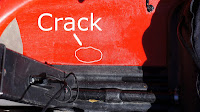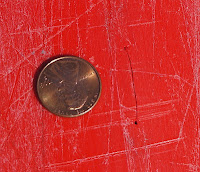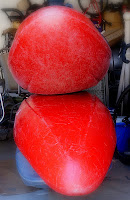But there are still cross link boats out there. Jackson Kayaks was using cross link up until a couple years ago. I have a couple cross link boats. And I recently managed to crack one of them - my Jackson Villain S. The boat is now in its fourth season and that's all I reasonably expect to get out of a creek boat, so no complaints that it cracked. It happened when I boofed a six foot drop and landed on a hidden rock - probably could have broken a new boat doing that. (just an aside to all you whitewater kayakers out there - just because a boat cracks doesn't mean its defective. If you abuse your gear - and that's a part of this sport - it may break. Yes, sometimes its the manufacturer's problem but sometimes it's the user's fault)
If you read my last post you'll know that I've ordered a new kayak to replace it (the new one is linear, btw). But I don't want to just give up on my old friend. It may be past its prime (so am I) but that doesn't mean its ready for the recycle bin. These days, we have the technology, we can rebuild it. And it doesn't even cost six million dollars.
Before I get into the nitty and gritty, let me talk a little about repairs. When a boat has a leak you can plug that leak up - that's not a repair. Duct tape, Gorilla tape, bituthene, aquaseal, lexal, chewing gum - all will plug a hole and some quite well. But they don't give the boat any structural support. And they don't really stick to the plastic so they are temporary (though that may actually mean years). That's fine if you just want to stop a leak, but if you're using the boat on hard whitewater then you will be using a boat that is not as strong. It will be prone to more cracks and a possibly catastrophic failure in a pin situation. Not a good idea. You are better served if you can actually fix the crack instead of just plugging it up.
As I said, plastic welding is not an option with cross link. I've tried it just to make sure. Plastic welding works by heating the plastic until it has a gooey consistency. Then you add in more heated plastic and mix it together to close up the crack. When the plastic cools it becomes solid again and the hole is gone. But cross link plastic doesn't get gooey. It goes from solid to liquid - it starts to run like water if you heat it too much. But there is relatively new material that can solve the problem: G/flex Epoxy.
The problem with most epoxies and glues is that they simply don't stick to plastic. But a few years ago West Systems came out with an epoxy that does stick to plastic. It also can handle more flexing which is very necessary when fixing a boat that's designed to have some flex. So here's how I used G/flex to fix the crack in my Jackson creek boat.
Step 1: Drill out the crack. The first thing to do with any crack is to make sure it doesn't spread. The way to do that is to drill out the ends of the crack so each end becomes a little circular hole. It may be counter-intuitive to make your problem bigger, but the stress on the seam of a crack makes it likely to split further. By drilling a circular hole you spread the stress out with no weak point so the crack won't grow larger. Even if you just want to stop the leak with some tape you need to do this.
Step 3: Prepare the plastic for the epoxy. Cross link plastic doesn't get soft when you heat it but it does change. I can't say exactly what's going on in there but when you heat it up you will see that it takes on a certain sheen. In this state it is easier for the epoxy to bond to the plastic. So after creating your canal (and cleaning it out good with some rubbing alcohol), get out the heat gun. If you don't have a heat gun use a hair dryer. If you don't have a hair dryer use something hot. A warm day and direct sunlight doesn't really do it.
Step 4: Prepare the back side. It's easy to forget that the epoxy might leak through the crack. So on the side you are NOT working on it's good to tape up the crack so it doesn't drip down onto the floor. You can use tape but I like to use either wax paper or saran wrap. Epoxy doesn't stick to either of them so it's simpler to take off. Use some painter's tape to put a saran wrap patch over the crack - make it as tight as possible - and you'll have an easy time removing it when all is said and done.
Step 5: Add the epoxy. G/flex is actually really easy to work with. Like most epoxies, it's a two part system: the epoxy and the hardener. Follow the directions but the stuff I used just requires a 1:1 mix of the different parts. Mix thoroughly and give it a minute to start reacting. You'll now have a limited amount of time to work with the epoxy before it hardens. Working time depends on temperature but G/flex has a good working life and you should have at least a half hour to play with - and it should only take a couple minutes. I use a Q-tip to transfer the epoxy into the crack but anything will do. Try to keep this neat since excess epoxy is actually a bad thing - not just from an aesthetic stand point. If you make a wide swath of epoxy it will be more likely to crack. You want to just fill your canal completely with maybe a little extra that can be sanded down if necessary. (note: my old boat had some additional cracks that did not go all the way through the hull. I scraped them out and added some epoxy as a preventive measure)
Let it dry for 24 hours and you should be good to go. You can use sand paper to smooth out any rough edges if you have them (you won't if you're careful). The smaller the crack the better this will work. The downfall with epoxy is that even the more 'flexible' G/flex is still stiffer than plastic. When your boat flexes and the epoxy doesn't it creates stress that can break the bond. If you paddle flat water or avoid hitting rocks you should be fine. Using it on harder whitewater is another story, so I went an extra step to make my boat a little more solid. This isn't necessary, but I thought it would be worth a try.
Step 6: Adding a patch. I had a thin strip of plastic that is designed to work as a keel strip on a sea kayak (it's called KeelEazy). I made another batch of epoxy and coated the plastic strip and glued it on the outside of my boat over the crack. Once again, it helps if you heat up the plastic first. I figure this patch will provide a little more strength to help prevent the boat from flexing as much. Also, since my boat is getting old, the spot where the crack happened was clearly weaker and thinner, so I think the extra layer might help me get some more life out of the old girl.
How well will this hold up? I don't know. I'm very confident that my boat doesn't leak anymore. I'm also sure that it can handle some easy stuff - it will make a great teaching boat and a good loaner for beginners. I'll have to get some more time and testing in before I would consider taking it on a remote class V run. Truthfully, I wouldn't take it on a remote run if I have another boat available. Even without the patched up crack, an old boat that's ready to give out is just asking for trouble. But it's fine for many other uses and that's what I'll be using it for.
UPDATE 4/15/15: The good ol' Villain S has been pretty much retired for the past two years, so I can't say that I've done a lot of paddling to test the repair. I've done some teaching out of it and it held up just fine. Recently I took it down an 18 mile class IV wilderness run - an overnighter no less. The first day I avoided the rocks, mostly because I was leading a first-timer down the river, and everything held up just fine. The second day my follower got more confident and I started doing some boofing. Oops. All that really happened is that the KeelEazy patch started to peal back a little. It could be because of the epoxy I used to adhere it instead of the normal adhesive it comes with. More importantly, the G-Flex epoxy patch of the crack held up solidly. After a full day of working it, including a boof onto a rather pointy rock, the repair is still 100% dry and the boat feels strong. I still won't take it on anything hard and remote, but maybe hard OR remote. G-Flex is good stuff.


















